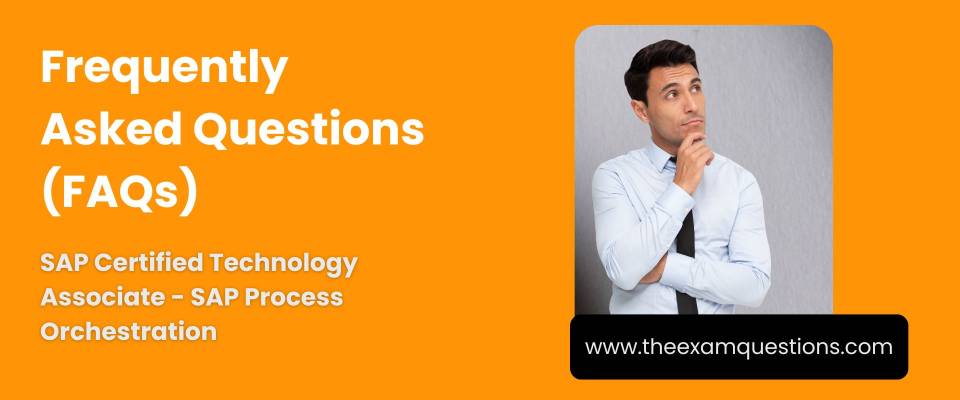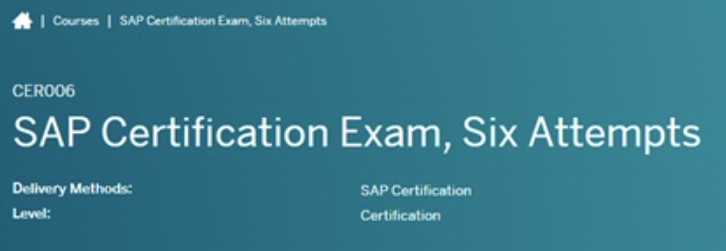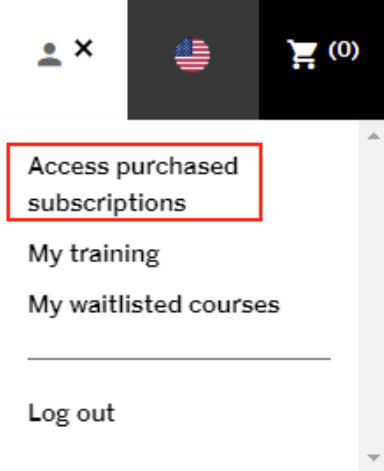FAQ - SAP Certified Technology Associate - SAP Process Orchestration

Here we are listing all SAP Certified Technology Associate - SAP Process Orchestration Frequently Asked Questions. These are mostly asked when appearing for SAP Process Orchestration Exam. Once you go through it, this will help you to better prepare for exam.
What are the total questions for the C_PO_7521 exam?
80 questions
What is the cost of C_PO_7521 exam or SAP Process Orchestration certification fees?
200 USD if you purchase CER001 (1 attempt) and 500 USD if you purchase CER006 (6 attempts).
What is the passing percentage for SAP Process Orchestration exam?
65 Percentage
What is the duration of exam C_PO_7521?
180 mins
What are the topics covered in exam C_PO_7521?
- Business Processes Modeling and BPMN 2.0 (Business Process Management Notation), (> 12%) => Explain the difference between BPM, and Business Workflow, sequence diagrams, the perspectives in NWDS, Message Flow, Data Flow, Association, the Configuration of BPMN models; Model a business process List the BPMN types of Process Diagrams; Describe the elements of BPMN 2.0; Develop business processes and flow models.
- The Role of the Advanced Adapter Engine Extended (AEX), (8% - 12%) => Define the Advanced Adapter Engine Extended (AEX), list the functionality of the Advanced Adapter Engine Extended (AEX); Explain how to Create an Advanced Adapter Engine Extended (AEX) integration flow.
- Basic Concepts System Landscape Directory (SLD) and Enterprise Service Repository (ESR), (8% - 12%) => Describe the use of the System Landscape Directory (SLD), the Enterprise Service Repository (ESR), the Business systems Technical systems and the use of Software Components in the ESR; Analyze Interface Objects in the Enterprise Services Repository.
- Mappings, (8% - 12%) => Explain how to create Message Mapping objects, the message and value mapping process and describe the types of mapping programs, describe how to create an operation mapping in the ESR and the default matcher.
- Operations and Process Monitoring in SAP Process Orchestration, (8% - 12%) => Explain how to Use the SAP NetWeaver Administrator functionality, the Operations tab in the NetWeaver Administrator, Certificates, Restart and Recovery and how to Access SAP Process Integration Monitoring; Start Business Processes; Define the Lifetime of Business Processes; Configure Process Orchestration in NetWeaver Administrator (NWA)Describe monitoring of the business processes and the AEX.
- Configuration of iFlows in NetWeaver Developer Studio (SAP NWDS), (8% - 12%) => Describe the use of the perspective in SAP NetWeaver Developer Studio, and how data types are mapped in SAP NetWeaver Developer Studio; Describe data objects and iFlows; List the available data types; Describe Data Types in BPMN Processes.
- SAP Business Process Management Development Steps, (8%) => Outline the configuration of business processes.
- SAP Business Rules Management (BRM), (8%) => Describe SAP Business Rules Management (BRM), the justification process for developing a new Business Rule and describe rulesets; Describe Rulesets.
- SAP Processes Integration Architecture, (8%) => Explain the difference between Process Orchestration and Process Integration, and how to establish the work environment for process creation; Describe the basic SAP Process Integration Architecture, the tools available for business process development, and message processing.
- Roles and Authorizations of a BPMN Process, (8%) => Describe Software Catalog (Products and Software Components), the SAP Component mode and the use of the Objects of the Component Model.
- Integration Objects in the Integration Directory, (8%) => Explain how to configure a scenario in the Integration Directory, how to process messages using the advanced adapter engine and the integration objects in the Integration Directory.
- Basic Concepts for SAP Business Process Management Integration Flow (iFlow), (8%) => Explain process context.
What books needs to be read for exam C_PO_7521?
1. BIT800 => Process Orchestration Overview
2. BIT500 => SAP Java Process Integration
Where to get Study Material and books for C_PO_7521?
You can check here SAP Process Orchestration books.
In how many languages C_PO_7521 exam available?
English
What is the level of SAP Process Orchestration exam?
Associate
What is the process to register C_PO_7521 exam?
- Go to training.sap.com and register with your E-Mail id.
- Confirm your email address and finish the registration.
- If you are planning to take only this exam, then you need to buy for Single attempt subscription which is CER001. CER001 giver 12 months period in which you can schedule the C_PO_7521 exam.

- Search for product CER001 on SAP website and add it to cart and do the checkout.
- If you are planning to do multiple SAP certifications, then you should consider buying CER006 product. CER006 also gives 12 months period in which you can schedule maximum 6 exams.

- Once you have purchased either CER001 or CER006, you will get access to SAP certification hub.
- Click on your profile icon and select ?Access purchased Subscriptions? as shown below:

- Go to SAP certification hub. click on ?Exam Dashboard?. Next, click on ?Schedule an exam? and you are good to go.

- Successful completion will make you receive an SAP Certification digital badge for your accomplishment.
How is the exam conducted?
SAP C_PO_7521 Certification exam is remotely proctored via a webcam on your PC or laptop, and you can schedule your exam 24/7 via Certification Hub.
Do I need to go someplace to take the C_PO_7521 exam?
No, exams are available online 24/7 and each exam is proctored remotely. You can take exams anywhere in the world as long as you have an Internet connection and a laptop or desktop computer with a webcam.
Do I need to be alone to take exam?
Yes, phone should also be switched off. Your exam supervisor or examiner will ask you to rotate your webcam around the room prior to beginning your SAP Certification exam. Please ensure the area contains only permitted items approved by your exam supervisor. Whiteboards and bulletin boards must be cleared, erased, or covered, unless they are facing away from you. All cell phones, tablets, and other communication or recording devices must be removed from the computer area.
Can I take SAP C_PO_7521 Certification exam on a tablet computer?
No, tablets are not supported.
What do I receive after successful completion of exam?
Successful examinees receive an SAP Certification digital badge for their accomplishment.
What is the benefit of taking the exam?
- Gain a highly recognized accreditation of excellence.
- Differentiate yourself in the labour market.
- Validate your skills to execute with confidence.
- Possibility to attain higher wages and billable rates with a highly valued credential.
Can I retake for SAP Process Orchestration exam, if fail?
You can attempt C_PO_7521 exam 2 more times. If in worst case, you still could not clear the exam after 2 times, then you will have to wait for next version of exam to arrive.
How can I get the practice questions for exam C_PO_7521?
Practice questions are very important to understand the pattern of exam. You can check C_PO_7521 practice questions here.
What topics are covered in Book BIT800 (Process Orchestration Overview)?
- Introduction to Process Orchestration
- Explain SAP Business Technology Platform (BTP)
- Outline the basics of Process Orchestration
- Outline the main objects of BPM
- Outline BRM
- Outline Advanced Adapter Engine Extended (AEX)
- Run business processes on an AEX
- Business Process Overview and Development Steps
- Outline the configuration of business processes
- Develop business processes
- Explore the development infrastructure
- Outline business processes
- Outline the elements of a BPMN process
- Sketch the purchase order process
- Explain the procedure models
- A BPM Process
- Outline the roles and authorizations of the main process in BPMN
- Import objects into a process
- Outline start and end events for PO
- Explain service interfaces
- Add activities to a business process
- Call a web service from an automated activity
- Connectivity with the Advanced Adapter Engine Extended (AEX)
- Explain the business case AEX
- Explain the SAP Process Integration Designer
- Monitor messages with Process Integration Monitoring (PIMON)
- Test the procurement process with AEX
- Data Flows
- Define process context
- Explain data objects
- Create mappings
- Explain gateways
- Apply data transformations by using functions
- Explain notification activities
- Other Objects
- Explain the process modes
- Explain the various UIs and tasks
- Create a user interface with SAPUI5
- Create tasks
- Deployment and Testing of a Process
- Explain compiling and deploying of PO processes
- Explain the configuration of the PO processes
- Use service groups
- Process Tasks and Monitors
- Manage process desk tasks
- Use the Business Process Management (BPM) inbox
- Monitor a procurement process
- The Complete Integration Process
- Configure referenced activities
- Explain boundary events in the delivery and purchase order process
- Execute the purchase order process
- Explain testing and monitoring of PO processes
- Business Rules Management (BRM)
- Explain Business Rules Management (BRM)
- Create rules with the Rules Composer
- Use the Business Rules Manager
What topics are covered in Book BIT500 (SAP Java Process Integration)?
- SAP Process Integration Architecture
- Explain the SAP Business Technology Platform
- Explain the Enterprise Service Bus
- Explain SAP Process Integration architecture
- Navigate to the Enterprise Services Repository (ESR)
- Navigate to the Integration Builder
- Configure the Integration Designer in Eclipse
- Work with SAP NWDS 7.5
- Explain SAP Process Orchestration and the Advanced Adapter Engine (AEX)
- The System Landscape Directory (SLD)
- Use product and software component terminology
- Create products and software components in the System Landscape Directory (SLD)
- Import software components from the SLD into the Enterprise Service Repository (ESR)
- Implement technical systems in the System Landscape Directory (SLD)
- Maintain the SAP NetWeaver Application Server for Java and ABAP in the SLD
- Create third-party technical systems in the SLD
- Maintain Business Systems in the SLD
- Import a business system into the SLD
- Interface Objects in the Enterprise Service Repository (ESR)
- Use the Enterprise Services Browser in SAP Integration Designer Perspective in Eclipse
- Access the ESR objects
- Search the ESR objects
- Display data types
- Create message types
- Create interface objects
- Import interface objects into the ESR
- Define the QoS and message processing types
- Object Mapping in the Enterprise Service Repository (ESR)
- Display a message mapping
- Create message mappings
- Create an operation mapping in the ESR
- Configuration of Integration Directory (ID) Objects
- Create a communication channel
- Create an AEX integration flow
- Validate XML
- SAP Process Integration Operations
- Access SAP Process Integration Monitoring
- Use the SAP NetWeaver Administrator functionality
- Explain the difference between logging and staging
- Configure the logging and staging behavior
- Connectivity Options for SAP Process Integration
- Use different adapters
- HTTP Connectivity Options
- Use the HTTP_AAE (Java) adapter
- Configure the SOAP sender adapter
- Configure the SOAP receiver adapter
- Use the proxy configuration
- Use the server proxy
- Use the client proxy
- Analyze the proxy configuration
- Use web services
- Create a web service based on proxy technology
- File Adapter Configuration
- Configure the receiver File/FTP adapter
- Configure the sender file adapter
- SAP Process Integration Test Tool
- Describe the architecture of the PIT tools
- Set up the PIT landscape
- Create and execute a test case
- Perform verification
- Work with jobs
- Use the web-based user interface
- Execution of Cloud Integration Content with SAP PI
- Describe the integration challenges
- Describe the basics of SAP BTP - Integration Suite
- Use the Cloud Integration Management Cockpit
- Use the monitoring
- Other Connectivity Options
- Explain other connectivity options
- Use the REST adapter
- Expose a function module as RESTful service
- Consume a synchronous RESTful service
- Advanced Mapping Concepts
- Explain queues in message mapping
- Explain the impact of context selection and deletion
- Use the message-mapping debug process
- Map multiple messages
How to get SAP Process Orchestration certification dumps?
Check it out here: C_PO_7521 certification dumps
Tags:
C_PO_7521 FAQ | C_PO_7521 detail | C_PO_7521 study material | C_PO_7521 practice tests | C_PO_7521 sample questions | C_PO_7521 Pdf dumps